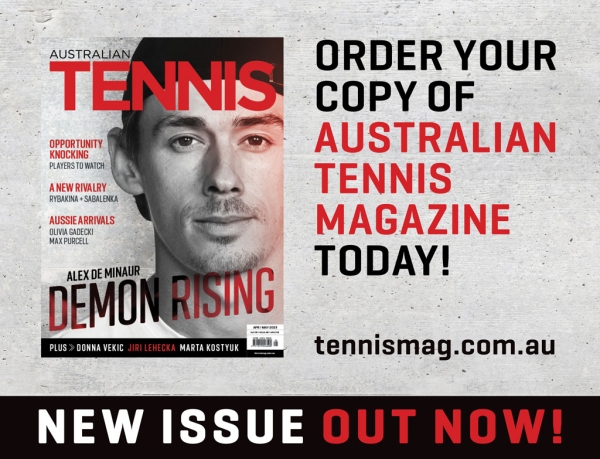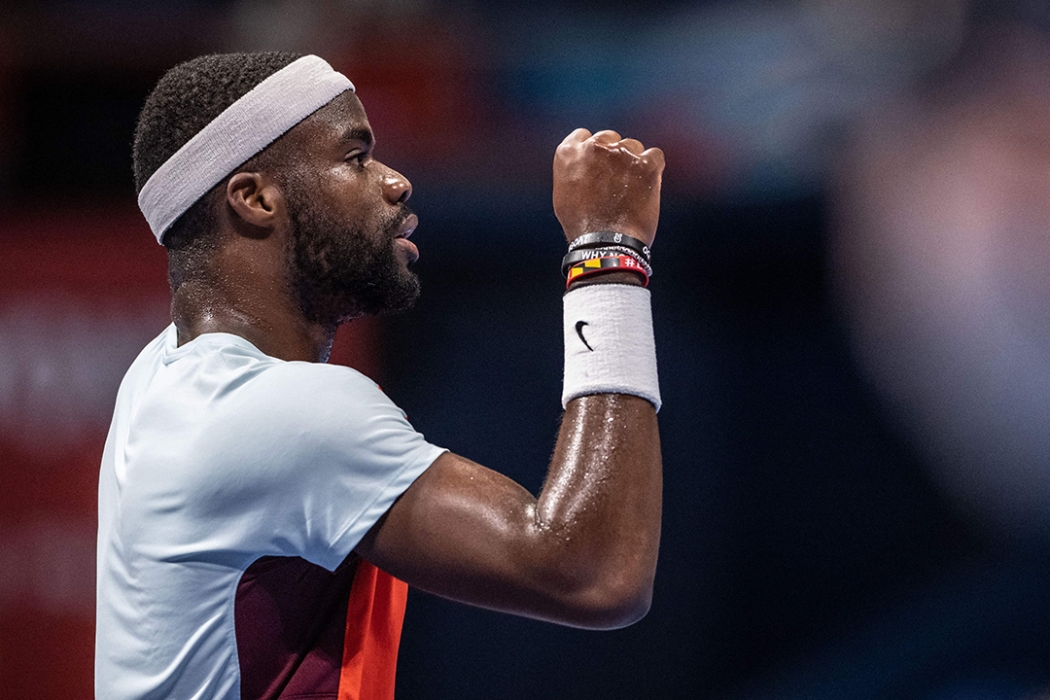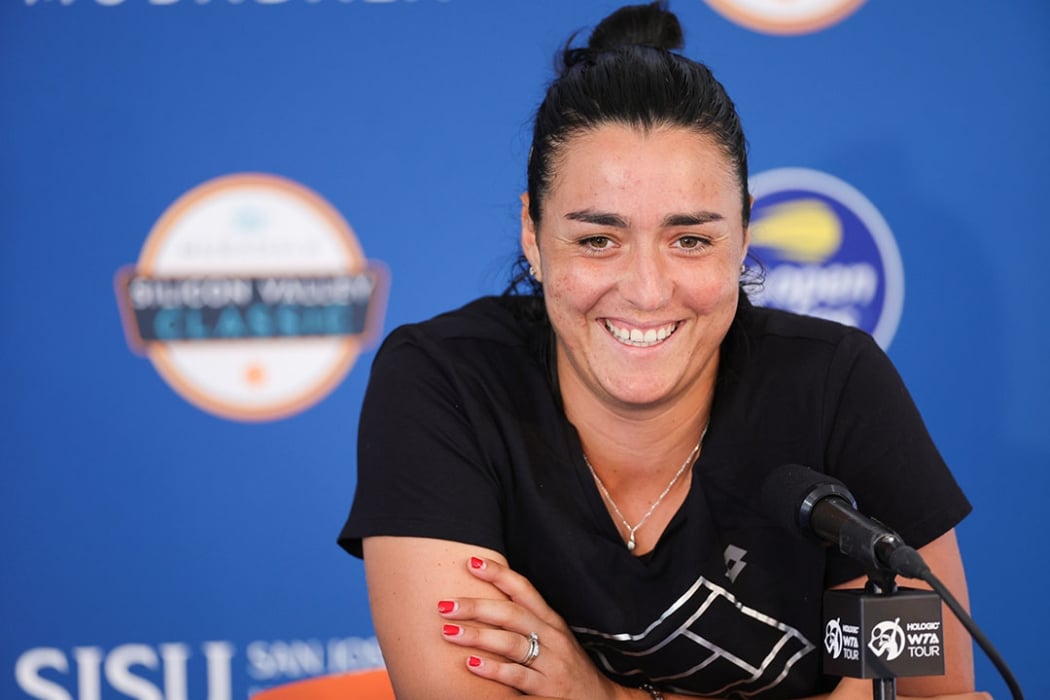The full version of this article first appeared in the April/May 2023 issue of Australian Tennis Magazine, one of the world’s longest-running tennis publications. For more in-depth features, news and analysis, you can subscribe now.
Asked to explain the origins of his ‘Demon’ nickname, Alex de Minaur good-naturedly relates the story of a junior coach, Ben Pyne, making a play on his surname and the on-court speed that – even then – was emerging as a trademark. “It kind of worked and I went with it ever since,” De Minaur smiled.
A decade or so later, the ‘Speed Demon’ reference is more relevant than ever, the Australian having combined his lightning-fast movement with a never-say-die attitude that has tormented opponents – and thrilled supporters – for years.
But any ‘demon’ attributes are tough to pinpoint in one of the game’s most committed competitors, whose role model qualities are evident in many aspects of the sport. They were most recently clear when De Minaur regained his status as Australia’s No.1 player – a position that provides him with unmistakable pride.
“It’s a great honour,” said the 24-year-old, who achieved the milestone by claiming his seventh, and biggest, singles title at the Acapulco ATP 500 tournament in February, which boosted his return to world No.18.
“I’m happy to be in a position where maybe I can inspire some kids here and there (and to) show that with a lot of hard work and sacrifice, you can accomplish some great things in life.”
It takes only the briefest glance at De Minaur’s expansive record to appreciate how much those words ring true. The Sydney-born athlete showed an intense dedication to tennis from the time he began lessons as a three-year-old at Carss Park in the city’s south. One of his first coaches, Cindy Dock, fondly recalls how the dedicated young player was rarely spotted without a racquet.
“He just loved swinging his racquet around and hitting balls on all the walls at the tennis centre,” Dock told tennis.com.au in 2021. “The challenge at that age is to keep kids motivated, but Alex just loved it. Even then he’d chase down everything. You actually had to tell him to go home, otherwise he would have stayed on court all day.”

Alex de Minaur is the cover star of the April/May 2023 issue of Australian Tennis Magazine.
The passion soon translated to professional potential, with the teenage De Minaur peaking at world No.2 on the junior tour. It was followed by rapid progress at ATP level; the Australian was twice a runner-up at the Next Gen ATP Finals (to Stefanos Tsitsipas in 2018 and Jannik Sinner in 2019) and after climbing 177 rankings places to world No.31 within the space of a season, voted by peers as the ATP Newcomer of the Year for 2018.
While many sparkling milestones have followed – including a first ATP title auspiciously claimed in his home city of Sydney in 2019 – the most important turning points have arguably occurred over the past year.
In a stellar 2022 season, De Minaur made maiden fourth-round appearances at the Australian Open and Wimbledon. He added a sixth career title in Atlanta and claimed a personal-best match 47 match wins – including three over top-10 opponents. Victories over Matteo Berrettini (at the ATP Cup), Cameron Norrie (Barcelona) and Daniil Medvedev (the Paris Masters) provided a solid foundation for even more impressive performances early this year.

At the inaugural United Cup in Sydney, De Minaur claimed a first win over Rafael Nadal in the four matches they’ve contested. He continued a remarkable record with victory over Andrey Rublev in Rotterdam, and the 10th-ranked Holger Rune in Acapulco.
“I think it was when I finally was able to get my first win against Medvedev. That kind of triggered something in me that that it is possible, it’s something that you can accomplish. It’s not something that’s impossible to do,” De Minaur relates of his improving record over big-name opponents.
“I had a lot of close ones beforehand and until you actually get the win and you know that you can keep on doing that, then it’s very tough to believe it. But now I believe it every time I step out there against any of these players.
“I might not play unbelievable tennis every day, but I know I’m going to fight to the end. I’ve got a whole lot of heart in this little body of mine.”
The Australian No.1 also has a remarkable work ethic, helping to develop the athleticism that’s now considered his biggest on-court weapon. “There’s been a lot of work being put in behind the scenes to get the most out of myself,” he related. “It’s amazing to see the results and those attributes in the key moments really getting me, basically, my biggest title.”
Those qualities have also helped De Minaur thrive in his favoured team events. As the nation’s No.1 player, he won six of seven matches in Australia’s runner-up finish at the 2022 Davis Cup Finals.
“There is something special about representing your country and being part of this team,” said De Minaur, who had the number 109 tattooed on his chest after he became the 109th player to represent the Australian Davis Cup team in 2018. “This has always been a dream of mine, and I will always do everything in my power to try and deliver for my country, my teammates, and my captain. It’s pride, it’s passion and it’s a whole lot of heart.”
That captain, of course, is former world No.1 and two-time Grand Slam champion Lleyton Hewitt, who was De Minaur’s adored childhood idol. Many noted the similarities in style when the more senior Australian became his mentor. “Growing up, watching him play, one of the things that always stuck was his fighting ability and his never-say-die attitude. That’s one of the things that I’ve always wanted to replicate when I play.”
Adolfo Gutierrez is another long-time influence, De Minaur first teaming with the Spanish coach at age nine. It followed his family's move from Sydney to Alicante, where they initially remained for eight years. With a Spanish mother (Esther) and a Uruguayan father (Anibal), De Minaur now divides his time between both nations and credits his dual upbringing as an important factor in shaping his game.
Still, there’s no questioning his loyalty, as De Minaur told ATP Media in 2020. “At the end of the day, I probably spend half my life in each country but in my heart, I’ll always be Australian,” he said.
The recent addition of Australian Peter Luczak to his coaching team has added to that outlook.
Further support comes from British-born girlfriend and fellow player Katie Boulter, who currently sits at world No.157 on the WTA Tour. “She’s amazing,” he commented of Boulter at the Australian Open. “I guess it’s the beauty of us being in the same sport. We kind of understand each other. We know what to expect, how we can help each other in certain situations.”
It’s the perfect setting for De Minaur and his team to target the next milestones, with a top-10 breakthrough a realistic ambition. “There’s always the goal of kind of stepping it up to the next level,” he noted.
“If I could get us close to that top-10 mark, that would be an unbelievable way to finish the year.”



